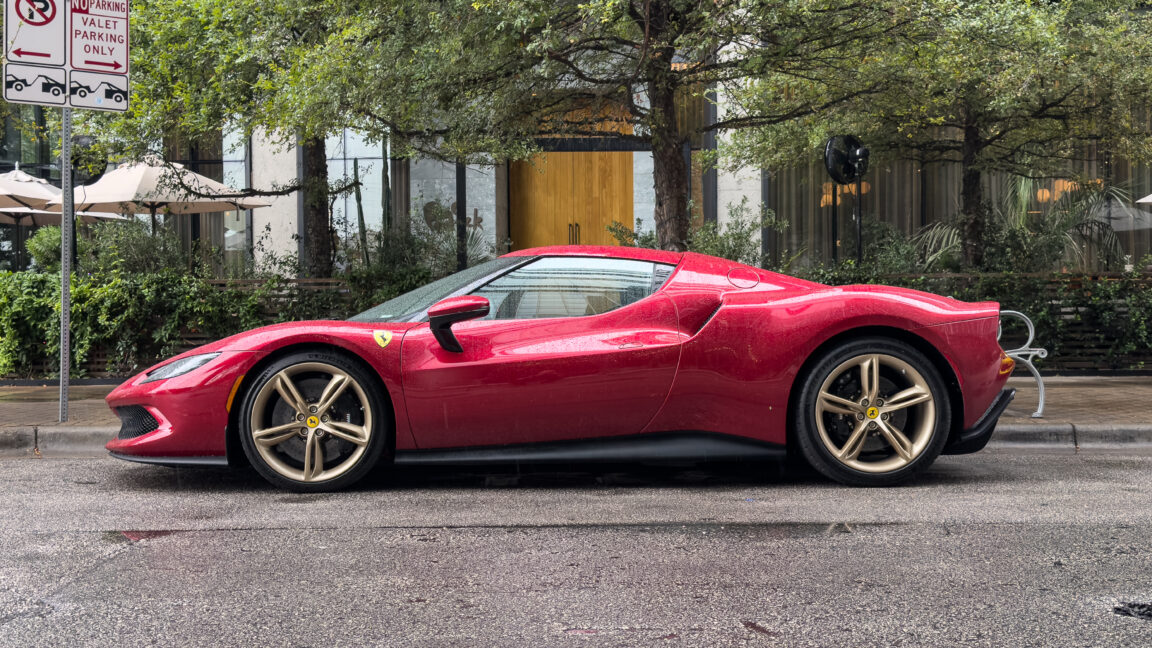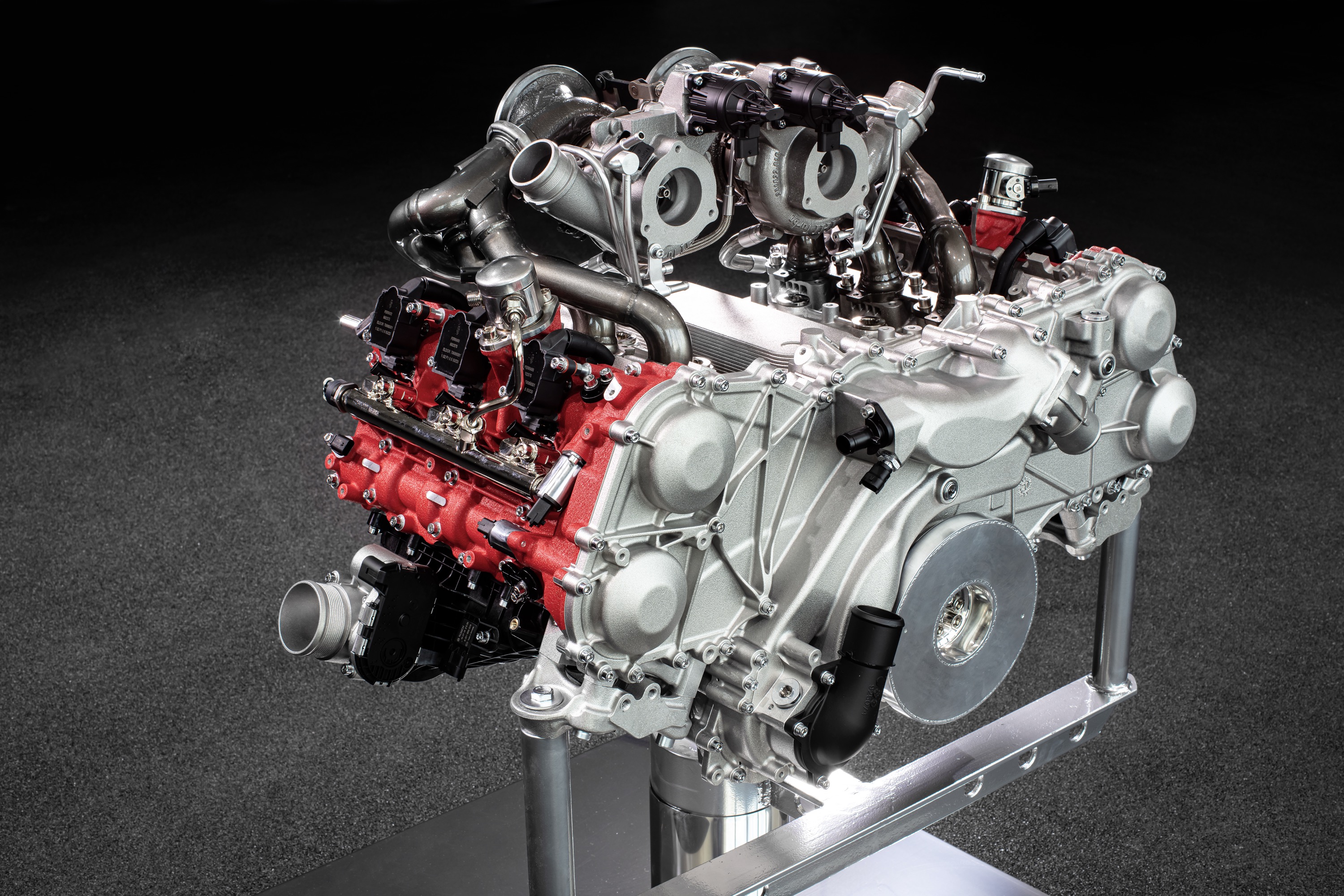
Credit: Jonathan Gitlin
The first time I drove this generation of mid-engined Ferrari, it was on a curated route on the company’s home turf. As the Po Valley gives way to the Apennines, you find plenty of narrow winding roads, steep gradients, and hairpin turns. It was an engaging few hours of driving, but it was too brief to properly assess some of the 296’s technology. I found the ride firm but comfortable on rough Italian tarmac and the hybrid system easy to operate, flicking into calm-and-quiet electric-only mode through the villages I encountered.
That was back in 2022 during the unveiling of Ferrari’s 499P race car. Last month, I met the 499P again as it visited the Circuit of the Americas in Austin, along with the rest of the World Endurance Championship. And that afforded another chance to get to know the 296, with three days rather than three hours to form an impression.
Head west from Austin and you’ll find twisty roads that wrap around the hills. It would have been easy to spend an entire day out there, but that seemed repetitive—I’d experienced the 296’s back road behavior already. Plus, there were things to do at the racetrack, although I’ll admit I took the long way there and back each day.
Driving among the AVs
For mixing it up in downtown traffic—among the dozens of all-white Waymo Jaguars and brightly wrapped Zoox Toyotas doing their autonomous driving thing—the Ferrari’s eDrive mode is perfectly sufficient. It uses the axial flux electric motor that lives between the 2.9 L V6 engine and the eight-speed dual-clutch transmission, but the donut-shaped motor’s 165 hp (123 kW) and, more importantly, 232 lb-ft (315 Nm) are all you need to move the 296’s roughly 3,300 lbs (1,500 kg) at city speeds. Visibility is good looking forward and is adequate otherwise, and the throttle mapping makes it easy to measure out just as much acceleration as you need.
Beyond the confines of the city center, you’ll want the contribution of the V6’s 654 hp (488 kW). There are three modes to choose from. Hybrid is best when the lithium-ion traction battery is charged, and the car’s brain will cut the V6 as and when necessary to save some fuel. If the 7.4 kWh battery is depleted, switching into Performance mode is a solution. This keeps the internal combustion engine fired and uses spare power to keep topping up the pack. It also sounds more raucous.
Finally, there’s Qualify mode, which gives you the maximum of both electric motor and V6, which combine to generate 818 hp (610 kW) and 545 lb-ft (740 Nm). This mode doesn’t care about maintaining a state of charge in the battery and is probably best-suited for a track day. For a turbocharged engine, the V6 revs freely, and Ferrari has imbued it with a torque curve more fitting of something naturally aspirated: peak torque doesn’t arrive until 6,250 rpm, so you have an incentive to let the revs soar. LED lights in the steering wheel rim tell you when to shift, and the large carbon fiber paddles are always at your fingertips.

The 296’s V6 uses a 120-degree V angle and mounts the turbochargers in the valley between the cylinder banks.
Credit: Ferrari
Truth be told, any of the three hybrid modes will generate sufficient power and torque to keep up on Texan highways, surrounded as you are by speeding SUVs and lifted pickup trucks. Here, the Ferrari’s deep metallic red paint and howling exhaust note are a bonus—anything that helps other road users notice there’s a car down by their wheels is helpful. And at these higher speeds, it soon became apparent that the 296 feels quite different from the last mid-engined Ferrari we tested.
The old 488 GTB felt almost nervous at speed, as if it were skating along the road’s surface. The 296 has a more advanced electronic chassis control system and still features some of the most direct steering you’ll find in any car on sale today, but the experience at highway speeds is far more planted, especially in the rain.
Even in its lowest drag configuration, the 296’s bodywork generates more aerodynamic downforce than the 488 or F8, and unlike those cars, its active aerodynamics are designed to increase downforce when activated—in the older cars, the active aero’s purpose was to make the car more slippery through the air, similar to Formula 1’s drag reduction system. Accelerate hard and the rear spoiler deploys, adding an extra 220 lbs (100 kg) of downforce to push the rear wheels onto the road surface. The underbody even generates ground effect, helping to suck the car to the road at speed.
HMI fail
If more time with the 296 GTB meant the opportunity to get more familiar with how it handles, it was also a chance to get more familiar with the rest of the user experience. And here, things weren’t quite as great. For starters, you should expect slightly better interior trim quality for a car that starts at around $350,000 before you start adding options. But the aluminum chassis was visible in the passenger footwell, where some of the carpets had been misaligned before being glued in.
A larger annoyance concerns the multifunction steering wheel. Like many other OEMs, Ferrari has moved to capacitive controls for its steering wheel. But the company puts far more controls on its steering wheels than most of those other automakers; other than a panel on one side of the driver’s dash for the lights and another on the other side for the climate controls, you need to use the control panels on the wheel to do basically anything. And it’s frustrating.
Switching between powertrain modes works mostly fine, but it would be much better if this was a physical “manettino” like the one on the other side of the wheel that toggles you through the chassis drive modes. The biggest annoyance is the D-pad that lives on the right spoke. You need this to navigate through any of the car’s settings or if you want to use Apple CarPlay or Android Auto, but it’s simply not up to the task. Swipes only sometimes register, making it nearly unusable. In fact, the wheel is so frustrating to use that it’s almost enough to offset all of its positive qualities.
The good news is that Ferrari has seen the error of its ways and introduced a new multifunction wheel with physical buttons, which is retrofittable to the 296, as well as the other Ferraris that have been afflicted with the capacitive wheel.

-
 C114 Communication Network
C114 Communication Network -
 Communication Home
Communication Home


